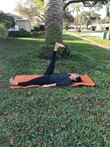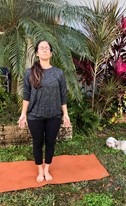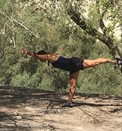By Rabbi Danielle Upbin
Note: This blog post was featured as part of our #HeshbonHodesh: Nisan monthly newsletter.
As a rabbi and yoga instructor, I have had the privilege of inviting my students through a spiritual journey of the oytiot, exploring the nuanced meaning of the Hebrew letters through dialogue and creative embodied expression. The otiyot are more than just broken down sounds. They are rich in symbolic meaning. The mystical tradition posits that the otiyot are even the blueprint of Creation.
Because the otiyot contain so much spiritual power, when we process them through the lens of certain spiritual questions, we find that they speak to us, opening up new creative avenues of exploration, insight, and meaning. The world of the otiyot swirl with symbolic meaning, lending themselves to an interpretive process and basis for discussion that is at the heart of the Passover ritual experience.
This year, we might consider an embodied experience of this process that combines analysis of the letters with playful variations of yoga postures. The yogic tradition of breathing and moving intentionally can add an additional layer of interpretation that can be both playful and up-lifting. As we unpack these letters, we create a new midrash that is wholly personal, rooted in antiquity, and quite healthy. These movements might help us unlock additional meaning as we learn from the wisdom of our own body.
Consider, for instance, the otiyot that comprise the famous injunction “Tze U’lmad” - צא ולמד, from the Maggid section of the Haggadah, directing us to expound upon the meaning of freedom. In the text that follows, we will explore how each letter of this phrase relates to freedom, as well as provide direction for embodying the letters. These interpretations and postures are just suggestions for you to find your way into your own otiyot journey.*
 צ Tzadee represents the values of righteousness and humility. If you look closely, צ tzadee is actually a combination of two letters: a bent over נ nun with a י yud on its back. צ Tzadee invites us to be God’s partner in the process of freedom, to lift those who are fallen, and to remain steadfast in our commitment to righteousness in this world. When we take the posture of צ tzadi, we embody this partnership in humility and strength.
צ Tzadee represents the values of righteousness and humility. If you look closely, צ tzadee is actually a combination of two letters: a bent over נ nun with a י yud on its back. צ Tzadee invites us to be God’s partner in the process of freedom, to lift those who are fallen, and to remain steadfast in our commitment to righteousness in this world. When we take the posture of צ tzadi, we embody this partnership in humility and strength.
Posture - Upright extended foot: Lay on your back with both legs stretching straight out on the ground. Using your core strength, lift one leg at a time up with a flexed foot, hold and breath, then switch legs. Repeat two or three times.
א  Alef is the boldest of all letters, the chief, Aluf. It symoolizes one, but also thousands. It is the opening sound of the Decalogue - the sound before sound. Its shape is comprised of a diagonal ו Vav transecting an upper and lower י Yud. Essentially, א Alef has God’s name written all over it. There is no freedom without God’s strong hand and outstretched arm beckoning us to reach upward and outward.
Alef is the boldest of all letters, the chief, Aluf. It symoolizes one, but also thousands. It is the opening sound of the Decalogue - the sound before sound. Its shape is comprised of a diagonal ו Vav transecting an upper and lower י Yud. Essentially, א Alef has God’s name written all over it. There is no freedom without God’s strong hand and outstretched arm beckoning us to reach upward and outward.
Posture - Star Variation: An empowering posture with feet firmly grounded, legs separated and strong, arms stretching up and out into the air. One foot pivots to the side, bending and straightening the knee. Hold posture for three breaths and release. Breathe deeply and release.
ולמד U’lmad:
 ו Vav stands firm, aligned and grounded, but it is also fluid - it is the prime connector. Grammatically, ו Vav has the unique ability to take on different sounds depending on what letter its precedes - “v’eh”? vah?, “ooh”, “oh”? Its ability to shift and adapt based on its situation is a valuable life lesson. Compassion begins with the ability to connect with others, to shed soften rigidity, to stand in another’s shoes. ו Vav teaches empathy and conviction, integral pieces in the dance of freedom.
ו Vav stands firm, aligned and grounded, but it is also fluid - it is the prime connector. Grammatically, ו Vav has the unique ability to take on different sounds depending on what letter its precedes - “v’eh”? vah?, “ooh”, “oh”? Its ability to shift and adapt based on its situation is a valuable life lesson. Compassion begins with the ability to connect with others, to shed soften rigidity, to stand in another’s shoes. ו Vav teaches empathy and conviction, integral pieces in the dance of freedom.
Posture - Mountain Pose: Feet firmly set on the ground, finding the balance between the right and left foot. Tuck tail bone under, draw belly in, chest lifted, shoulders drawn down away from your ears, soft gaze in front of you, grow taller with each breath.
 ל Lamed is our teacher, reminding us to continue to grow, learn, and share the wisdom we have accumulated. The Torah of freedom exists everywhere around us and within us, ready to be revealed. What are the lessons of freedom that are new to you this year? What lessons will transmit to others?
ל Lamed is our teacher, reminding us to continue to grow, learn, and share the wisdom we have accumulated. The Torah of freedom exists everywhere around us and within us, ready to be revealed. What are the lessons of freedom that are new to you this year? What lessons will transmit to others?
Posture - Chair pose: Stand with your feet and legs together.
Stretch your arms over your head. Sink into an imaginary chair, weight back in your heels. Keep your chest lifted, belly in, stretch your arms all the way through your fingers. You will feel this in your quadriceps and glutes! Listen to what your body is teaching you!
 מ Mem signifies Mayim, water - life giving, refreshing, nourishing, and cleansing. מ Mem invites us into a process of transformation, birthing new beginnings. Like Moses fetched out of the Nile, the hidden processes of Redemption are always underway. What happens when we open our hearts to the cry of enslavement? מ Mem reminds us to pay attention to the movement and softening within us. Unlike Pharaoh, we can reverse the hardening of the heart, feeling the current of life within and around us.
מ Mem signifies Mayim, water - life giving, refreshing, nourishing, and cleansing. מ Mem invites us into a process of transformation, birthing new beginnings. Like Moses fetched out of the Nile, the hidden processes of Redemption are always underway. What happens when we open our hearts to the cry of enslavement? מ Mem reminds us to pay attention to the movement and softening within us. Unlike Pharaoh, we can reverse the hardening of the heart, feeling the current of life within and around us.
Posture - Camel: This can be done from a standing position or standing on your knees. Placing your hands on the low back, fingers facing down, allow the head to drop back, inhale chest lifted, exhale, press the hips forward, backward bending, opening up the heart space. If you have more flexibility, (from the kneeling position), reach for your your heels one hand at a time. (This photo was taken on top of Masada!)
 ד Dalet is an open door beckoning us to walk through and discover the next step on our journey. When we encounter ד dalet, we ask ourselves, what door is opening? What door is closing behind me? Eliyahu Hanavi stands at each of our thresholds on Passover, anticipating that this will be the moment of our true redemption, reminding us to open that door and step through with him.
ד Dalet is an open door beckoning us to walk through and discover the next step on our journey. When we encounter ד dalet, we ask ourselves, what door is opening? What door is closing behind me? Eliyahu Hanavi stands at each of our thresholds on Passover, anticipating that this will be the moment of our true redemption, reminding us to open that door and step through with him.
Posture - Forward Extension: Stand with your feet together, hands on your hips or straight out in front of you. Hinge forward from your hips with a flat back, elongate your spine, gaze toward the floor four feet in front of you. Breathe, hold posture, and come back up with a flat back. Level up? Try balancing stick pose, like this one at Ein Gedi!
This year, may the ancient wisdom of the otiyot deepen our understanding of freedom and growth!… And next year in Jerusalem!
Read the Other Blog Posts in This Series:
Rabbi Mark J. Bisman: Freedom from the Perspective of Retirement
Rabbi Sandra Kochmann: Freeing Ourselves from the "Always" and the "Never"
Rabbi Eliav Bock: Connecting with the Divine in the Outdoors
Rabbi Mario Rojzman: The Ancient Jewish Vaccine Against Loneliness
Rabbi Ervin Birnbaum: The Story of the Exodus Ship
Rabbi Danielle Upbin is the Associate Rabbi at Congregation Beth Shalom in Clearwater, FL and Community Educator for the Jewish Federation of Florida’s Gulf Coast. She is a certified yoga instructor and singer/songwriter. Follow her @rabbi.dani and danielleupbin.com